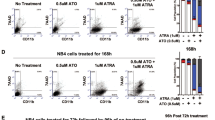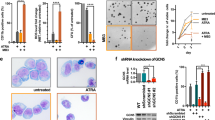Abstract
Acute promyelocytic leukemia (APL) is efficiently treated with a cell differentiation inducer, all-trans retinoic acid (ATRA). However, a significant percentage of patients still develop resistance to this treatment. Recently, arsenic trioxide (As2O3), alone or in combination with ATRA, has been identified as an alternative therapy in patients with both ATRA-sensitive and ATRA-resistant APL. Previous investigations restricted the mechanism of this synergism to the modulation and/or degradation of PML-RARα oncoprotein through distinct pathways. In this study, using several ATRA maturation-resistant APL cell lines, we demonstrate in vitro that the success of ATRA/As2O3 treatment in APL pathology can be explained, at least in part, by a synergistic effect of these two drugs in triggering downregulation of telomerase efficient enough to cause telomere shortening and subsequent cell death. Such long-term low-dose combinatorial therapy strategies, developed also to avoid acute side effects, reinforce the notion that the antitelomerase strategy, based on a combination of active agents, should now be considered and evaluated not only in APL but also in other malignancies.
This is a preview of subscription content, access via your institution
Access options
Subscribe to this journal
Receive 12 print issues and online access
$259.00 per year
only $21.58 per issue
Buy this article
- Purchase on Springer Link
- Instant access to full article PDF
Prices may be subject to local taxes which are calculated during checkout



Similar content being viewed by others
References
Hahn WC . Role of telomeres and telomerase in the pathogenesis of human cancer. J Clin Oncol 2003; 21: 2034–2043.
Stewart SA, Hahn WC, O'Connor BF, Banner EN, Lundberg AS, Modha P et al. Telomerase contributes to tumorigenesis by a telomere length-independent mechanism. Proc Natl Acad Sci USA 2002; 99: 12606–12611.
Mergny JL, Riou JF, Mailliet P, Teulade-Fichou MP, Gilson E . Natural and pharmacological regulation of telomerase. Nucleic Acids Res 2002; 30: 839–865.
Fu W, Begley JG, Killen MW, Mattson MP . Anti-apoptotic role of telomerase in pheochromocytoma cells. J Biol Chem 1999; 274: 7264–7271.
Dudognon C, Pendino F, Hillion J, Saumet A, Lanotte M, Segal-Bendirdjian E . Death receptor signaling regulatory function for telomerase: hTERT abolishes TRAIL-induced apoptosis, independently of telomere maintenance. Oncogene 2004; 23: 7469–7474.
Tallman MS, Nabhan C, Feusner JH, Rowe JM . Acute promyelocytic leukemia: evolving therapeutic strategies. Blood 2002; 99: 759–767.
Mistry AR, Pedersen EW, Solomon E, Grimwade D . The molecular pathogenesis of acute promyelocytic leukaemia: implications for the clinical management of the disease. Blood Rev 2003; 17: 71–97.
Puccetti E, Ruthardt M . Acute promyelocytic leukemia: PML/RARalpha and the leukemic stem cell. Leukemia 2004; 18: 1169–1175.
Gallagher RE . Retinoic acid resistance in acute promyelocytic leukemia. Leukemia 2002; 16: 1940–1958.
Ohno R, Asou N, Ohnishi K . Treatment of acute promyelocytic leukemia: strategy toward further increase of cure rate. Leukemia 2003; 17: 1454–1463.
Zhang P . The use of arsenic trioxide (As2O3) in the treatment of acute promyelocytic leukemia. J Biol Regul Homeost Agents 1999; 13: 195–200.
Chen GQ, Shi XG, Tang W, Xiong SM, Zhu J, Cai X et al. Use of arsenic trioxide (As2O3) in the treatment of acute promyelocytic leukemia (APL): I. As2O3 exerts dose-dependent dual effects on APL cells. Blood 1997; 89: 3345–3353.
Au WY, Chim CS, Lie AK, Liang R, Kwong YL . Combined arsenic trioxide and all-trans retinoic acid treatment for acute promyelocytic leukaemia recurring from previous relapses successfully treated using arsenic trioxide. Br J Haematol 2002; 117: 130–132.
Shen ZX, Shi ZZ, Fang J, Gu BW, Li JM, Zhu YM et al. All-trans retinoic acid/As2O3 combination yields a high quality remission and survival in newly diagnosed acute promyelocytic leukemia. Proc Natl Acad Sci USA 2004; 101: 5328–5335.
Chen GQ, Zhu J, Shi XG, Ni JH, Zhong HJ, Si GY et al. In vitro studies on cellular and molecular mechanisms of arsenic trioxide (As2O3) in the treatment of acute promyelocytic leukemia: As2O3 induces NB4 cell apoptosis with downregulation of Bcl-2 expression and modulation of PML-RAR alpha/PML proteins. Blood 1996; 88: 1052–1061.
Huang X . [Regulation of arsenic trioxide-inducing apoptosis]. Zhonghua Xue Ye Xue Za Zhi 1999; 20: 258–260.
Zhu J, Lallemand-Breitenbach V, de The H . Pathways of retinoic acid- or arsenic trioxide-induced PML/RARalpha catabolism, role of oncogene degradation in disease remission. Oncogene 2001; 20: 7257–7265.
Zhu J, Koken MH, Quignon F, Chelbi-Alix MK, Degos L, Wang ZY et al. Arsenic-induced PML targeting onto nuclear bodies: implications for the treatment of acute promyelocytic leukemia. Proc Natl Acad Sci USA 1997; 94: 3978–3983.
Zhang Y, Cao EH, Liang XQ, Qin JF . Increasing sensitivity to arsenic trioxide-induced apoptosis by altered telomere state. Eur J Pharmacol 2003; 474: 141–147.
Zhang TC, Schmitt MT, Mumford JL . Effects of arsenic on telomerase and telomeres in relation to cell proliferation and apoptosis in human keratinocytes and leukemia cells in vitro. Carcinogenesis 2003; 24: 1811–1817.
Liu L, Trimarchi JR, Navarro P, Blasco MA, Keefe DL . Oxidative stress contributes to arsenic-induced telomere attrition, chromosome instability, and apoptosis. J Biol Chem 2003; 278: 31998–32004.
Chen YC, Lin-Shiau SY, Lin JK . Involvement of reactive oxygen species and caspase 3 activation in arsenite-induced apoptosis. J Cell Physiol 1998; 177: 324–333.
Hei TK, Liu SX, Waldren C . Mutagenicity of arsenic in mammalian cells: role of reactive oxygen species. Proc Natl Acad Sci USA 1998; 95: 8103–8107.
Liu SX, Athar M, Lippai I, Waldren C, Hei TK . Induction of oxyradicals by arsenic: implication for mechanism of genotoxicity. Proc Natl Acad Sci USA 2001; 98: 1643–1648.
Chou WC, Hawkins AL, Barrett JF, Griffin CA, Dang CV . Arsenic inhibition of telomerase transcription leads to genetic instability. J Clin Invest 2001; 108: 1541–1547.
Roussel MJ, Lanotte M . Maturation sensitive and resistant t(15;17) NB4 cell lines as tools for APL physiopathology: nomenclature of cells and repertory of their known genetic alterations and phenotypes. Oncogene 2001; 20: 7287–7291.
Pendino F, Flexor M, Delhommeau F, Buet D, Lanotte M, Segal-Bendirdjian E . Retinoids downregulate telomerase and telomere length in a pathway distinct from leukemia cell differentiation. Proc Natl Acad Sci USA 2001; 98: 6662–6667.
Pendino F, Sahraoui T, Lanotte M, Segal-Bendirdjian E . A novel mechanism of retinoic acid resistance in acute promyelocytic leukemia cells through a defective pathway in telomerase regulation. Leukemia 2002; 16: 826–832.
Pendino F, Dudognon C, Delhommeau F, Sahraoui T, Flexor M, Bennaceur-Griscelli A et al. Retinoic acid receptor alpha and retinoid-X receptor-specific agonists synergistically target telomerase expression and induce tumor cell death. Oncogene 2003; 22: 9142–9150.
Lanotte M, Martin-Thouvenin V, Najman S, Balerini P, Valensi F, Berger R . NB4, a maturation inducible cell line with t(15;17) marker isolated from a human acute promyelocytic leukemia (M3). Blood 1991; 77: 1080–1086.
Duprez E, Ruchaud S, Houge G, Martin-Thouvenin V, Valensi F, Kastner P et al. A retinoid acid ‘resistant’ t(15;17) acute promyelocytic leukemia cell line: isolation, morphological, immunological, and molecular features. Leukemia 1992; 6: 1281–1287.
Gianni M, Koken MH, Chelbi-Alix MK, Benoit G, Lanotte M, Chen Z et al. Combined arsenic and retinoic acid treatment enhances differentiation and apoptosis in arsenic-resistant NB4 cells. Blood 1998; 91: 4300–4310.
Stewart SA, Ben-Porath I, Carey VJ, O'Connor BF, Hahn WC, Weinberg RA . Erosion of the telomeric single-strand overhang at replicative senescence. Nat Genet 2003; 33: 492–496.
Douer D, Tallman MS . Arsenic trioxide: new clinical experience with an old medication in hematologic malignancies. J Clin Oncol 2005; 23: 2396–2410.
Zhou J, Meng R, Yang BF . Comparing two arsenic trioxide administration methods in APL therapy. Chin Med J (Engl) 2004; 117: 1411–1413.
Acknowledgements
This work was supported by INSERM, the Ligue contre le Cancer, the Association pour la Recherche contre le Cancer (ARC nos. 4513 and 3416), and OTKA T-038163 (Hungary) research grant, BIO-00032/2001 Biotechnology Grant and F-1/03 French–Hungarian Bilateral Intergovernmental S&T Cooperation. FP was funded by the Fondation pour la Recherche Médicale (FRM). CD is a research fellow of Association pour la Recherche contre le Cancer. IT is supported by EMBO, the Société Française du Cancer and Société Française d'Hématologie.
Author information
Authors and Affiliations
Corresponding author
Rights and permissions
About this article
Cite this article
Tarkanyi, I., Dudognon, C., Hillion, J. et al. Retinoid/arsenic combination therapy of promyelocytic leukemia: induction of telomerase-dependent cell death. Leukemia 19, 1806–1811 (2005). https://doi.org/10.1038/sj.leu.2403923
Received:
Accepted:
Published:
Issue Date:
DOI: https://doi.org/10.1038/sj.leu.2403923
Keywords
This article is cited by
-
Combinatorial Effect of Arsenic and Herbal Compounds in Telomerase-Mediated Apoptosis Induction in Liver Cancer
Biological Trace Element Research (2023)
-
Effects of co-administration of arsenic trioxide and Schiff base oxovanadium complex on the induction of apoptosis in acute promyelocytic leukemia cells
BioMetals (2021)
-
Telomerase regulation by the long non-coding RNA H19 in human acute promyelocytic leukemia cells
Molecular Cancer (2018)
-
Azidothymidine hinders arsenic trioxide-induced apoptosis in acute promyelocytic leukemia cells by induction of p21 and attenuation of G2/M arrest
Annals of Hematology (2013)
-
Therapeutic effects of all trans-retinoitc acid combined with transarterial chemoembolization on Walker-256 hepatoma in rats
Journal of Huazhong University of Science and Technology [Medical Sciences] (2010)



